I’m surprised I didn’t see this research before, but I’m glad I have now, and wanted to quickly tell you about it.
Hand-drawn (traditional) animation and 3D (computer) animation have been separate forms for a long time. The over-abundance of computer animation has caused some people to mutter, but computer animation is easier and more effective in many ways, so some animators have tried to merge the benefits of both mediums. Oscar-winning Disney short “Paperman” is one such example of how such a style might work (still not able to replace hand-drawn in my opinion, but it comes very close and captures the general heart and soul very well).
But on this webpage, you can find a research paper by Eakta Jain (and Yaser Sheikh, Moshe Mahler, Jessica Hodgins) at Carnegie Mellon titled “Three-dimensional Proxies for Hand-Drawn Characters,” just one of several efforts made by Jain to somehow use traditional animation with modern technology. The included video shows the potential of combining 3D computer models for physics (with environments and cloth effects) with hand-drawn characters. It looks great, and was partially funded by Autodesk (creators of 3D software “Maya”) and Disney Research. Love or hate Disney, their research division really does catch on to some fantastic work.
Of course, it appears additional technical input is required on the artist’s part to make the two artworks mesh together properly, and I assume this is all pre-rendered and may have little to do with the potential in games or real time tech demos, but it looks good nonetheless.
The website I’m talking about is here: http://graphics.cs.cmu.edu/projects/threeDproxy/ . Give it a look, it might inspire you.


